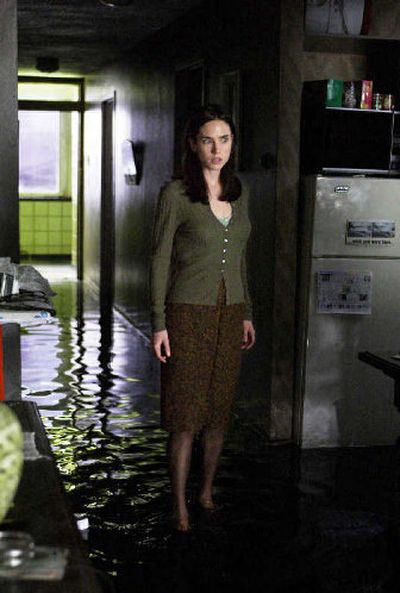All grown up

One is an Oscar winner, the other is a nominee. Both are on Hollywood’s A-list.
And both are this summer’s unlikely doyennes of darkness, headlining two of the season’s most talked-about chiller thrillers.
“Dark Water,” which opened Friday, showcases Jennifer Connelly as Dahlia, a single mother who is nearly drowning in her haunting memories of a gruesome childhood. Things get worse when she and her daughter move to an apartment that’s plagued by leaks, both real and imagined.
And in the voodoo drama “The Skeleton Key,” which opens Aug. 12, sunny Kate Hudson explores the dark side as Caroline, a caretaker for an elderly stroke victim who must grapple with some grim spirits in the Louisiana bayou.
Connelly won a best-supporting-actress Oscar for 2001’s “A Beautiful Mind.” Hudson earned an Oscar nomination for playing the groupie Penny Lane in 2000’s “Almost Famous.”
So how did two marquee names end up doing genre films more associated with blood, guts and crazed killers in hockey masks?
Because horror – once a lowbrow crowd-pleaser and studio moneymaker – has grown up. And it’s attracting big-name talent, both behind and in front of the camera.
“Horror is a genre that’s back. And because these two actresses get to top-line their movies, their paychecks are good. They get to be the star of their movie,” says Michael Speier, managing editor of Daily Variety trade magazine.
“Since ‘The Sixth Sense,’ a lot of horror movies have become smart and unique,” Speier says. “They’re not the bastard stepchild of genre films anymore.”
For Hudson, 26, “Skeleton Key” represented a chance to do “a lot of great character work and acting, so it felt more like a real movie than just a genre film.
“There’s something about Caroline which I totally relate to,” she says. “You want to face your fear instead of running away from it.”
Connelly says she cried the first time she read the script for “Dark Water,” acclaimed director Walter Salles’ (“The Motorcycle Diaries”) American remake of the 2002 Japanese original.
“I love the fact that it’s the kind of scary film where you don’t see the monster,” she adds. “You don’t even know who the monster is, really.”
Connelly concedes that she’s no fan of gory movies. In fact, she had seen only two – 1980’s “Dressed to Kill” and parts of the 1976 classic “The Omen” – before signing up for “Dark Water.”
To prepare for her foray into fear, Connelly, 34, watched horror flicks with her husband, actor Paul Bettany. Her favorites: “Rosemary’s Baby” (1968) and “Don’t Look Now” (1973).
The recent respectability of horror films can be credited to Anthony Hopkins, who won an Academy Award for his depiction of Chianti-loving Hannibal Lecter in 1991’s “The Silence of the Lambs,” the year’s Oscar winner for best picture.
The film, a hit both critically and commercially, made horror not only palatable but downright delicious.
” ‘Silence’ legitimized horror,” says David Skal, author of “The Monster Show: A Cultural History of Horror” (Faber & Faber, 2001).
For the most part, experts say, horror flicks are cheap to make and are very profitable both in theaters and on DVD.
They appeal to those desirable younger viewers. And they can help lesser stars raise their profiles.
A case in point is the 2003 version of “The Texas Chainsaw Massacre,” which starred Jessica Biel of TV’s “7th Heaven” and grossed $80.1 million. Now Biel is co-starring in “Stealth” and “Elizabethtown.”
And then there’s “The Ring,” another American version of a Japanese movie, this time about a creepy girl who appears in a deadly video. The 2002 movie, which grossed $129 million, transformed Aussie newcomer Naomi Watts from critical darling to a household name and box-office draw.
And in December, Watts will be seen in a remake of perhaps the most iconic fright flick of all time: “King Kong.”
Having Hudson and Connelly fronting two fear flicks gives the movies a patina of class while potentially raising the asking price of each actress – assuming the movies do well.
“Certainly having these actresses in them makes them worth a look and not seem just run of the mill,” says Martin Kaplan, a former Disney studio executive and now associate dean of the Annenberg School for Communication at the University of Southern California. “It separates the movies from the pack.”
Both Connelly and Hudson point out that their films aren’t your standard-issue killing sprees filled with knife-wielding maniacs named Freddy Krueger.
“This one, while it is on paper part of that trend, it also feels different because of the way Walter interpreted it,” Connelly says. “Every parent worries about being a good enough parent and worries about keeping their children safe.”
Hudson says that unlike her cynical character, she believes in voodoo, spirits and black magic
“This movie I wouldn’t consider a horror film,” she says, one where “you can lose yourself in it without having to think too much.
“Hopefully, if you do a good one, it makes you think a little.”